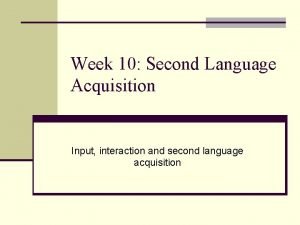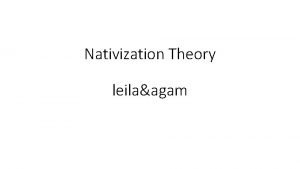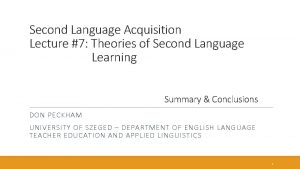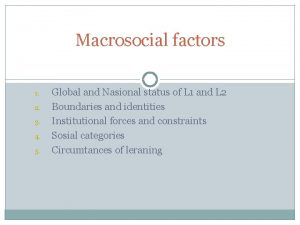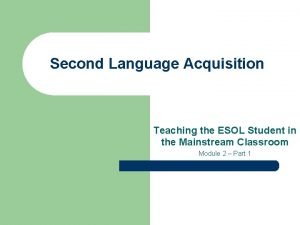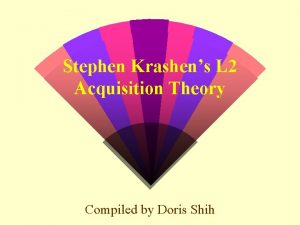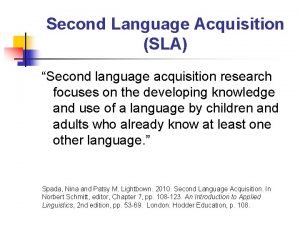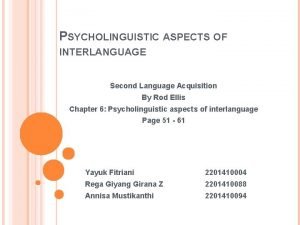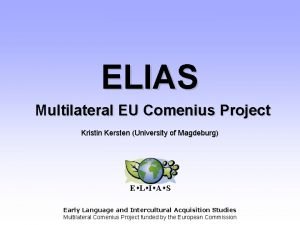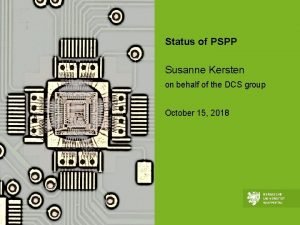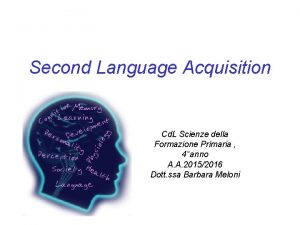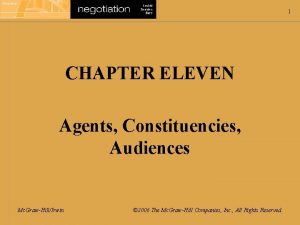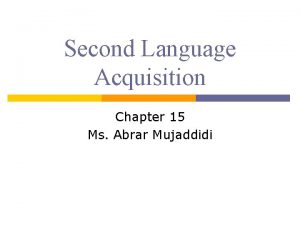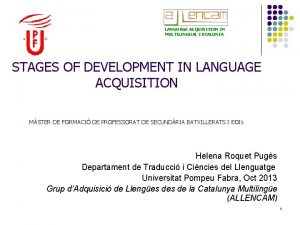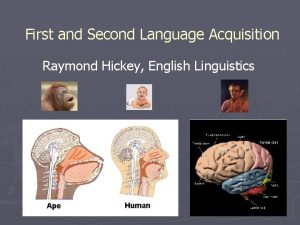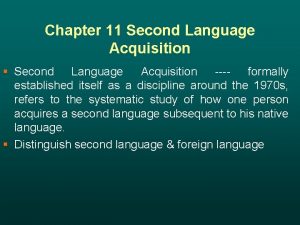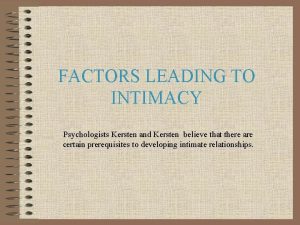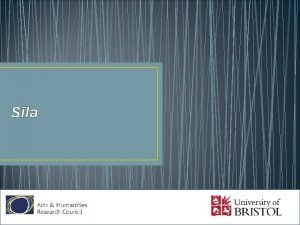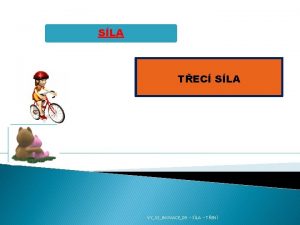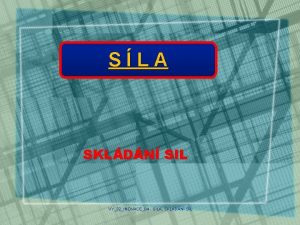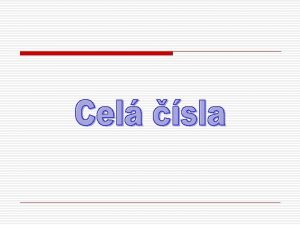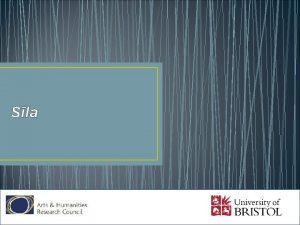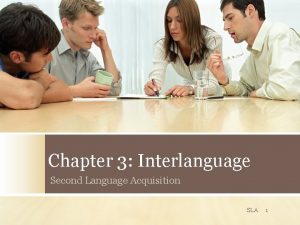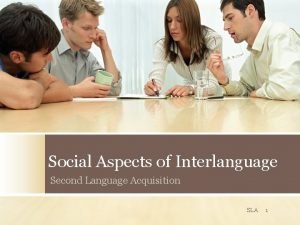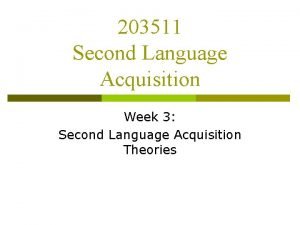Negotiations and Second Language Acquisition Margaret Kersten SLa




















- Slides: 20

Negotiations and Second Language Acquisition Margaret Kersten SLa. LS, Carleton University Ottawa, Canada Warsaw, June 2015

Overview • English for academic purposes • Methodology • Course design • Student feedback • Discussion

English for academic purposes • How do we prepare students to succeed at university? • What should the course objectives be? • How do we accomplish these objectives? • Should English courses teach only language?

Cognitive academic proficiency • Basic Interpersonal Communication Skills – 2 years • Cognitive Academic Proficiency – 5 -7 years • Academic language • Cognitive and critical thinking skills • • Compare/contrast Classify Evaluate Synthesise (Cummings, 2008)

What methods should be used? In order to: • prepare students for academic requirements • prepare students to cope with extensive reading • teach students how to use information from readings to produce their own texts • help sociolinguistic development

Language learning and acquisition • Development of linguistic competence • Acquisition: subconscious, “natural way”, “picking up language” – language rules not necessary for fluency • Learning: conscious effort to attain knowledge of language and language rules • Acquisition – central to linguistic competence • Learning – supporting role; monitors errors • Comprehensible input from texts, peers, teachers (Krashen, 1987)

Content-based instruction • Content – basis for course design • Natural acquisition: integration of four skills • Focus on meaning: social and communicative functions • Authentic texts • Language rules – supporting role; linked to content (no prescribed sequence) • Class dynamics • Student-centered • Group work; class discussions, problem solving tasks • Teacher – facilitator (Kasper, 1997)

Sustained-content instruction • Why not use regular university courses as a model? • Focus on one subject area • Input from a variety of sources • Assignments – typical for university courses • Benefits • Content knowledge • Academic language • Critical thinking (Pally, 2000)

EAP course • Advanced level EAP • students’ course load: EAP + three courses • Students – diverse backgrounds • • • Culture Language Education Program of study Age

Course design: theme choice • How do we decide on a theme that: • Is relevant to all students • Meets course objectives • Decision-making and negotiations • Everybody’s experience • Theoretical explanations easier to grasp • Social decision-making and negotiation – communication

Course design: components • Course-pack • Research assignment • Cases and role-plays What? How? Why? • Texts and activities • Cognitive tasks • Acquisition and learning

Texts and activities

Cognitive tasks

Acquisition and learning

Excerpts from negotiation journals What is he thinking? This is the worst offer I have received so far. After two days of waiting…I was so worried… it’s pretty stressful and I felt anxious waiting for the message. I will wait until tomorrow to think this better. It took me about two days to reach a decision regarding the offer that Mr. Mosico sent me.

Negotiation report • Objectives – test • Content knowledge • Critical thinking • Language • Sources • • • Course-pack NSSs Inspire Questionnaire Research assignment

Students’ feedback (1) • Theme • 100% - appropriate for the development of language skills and study skills • 90% - would use negotiation skills acquired in real life and at work • 81% - engaged in both face-to-face and Inspire negotiations • 90% - gained awareness of cultural differences in decision-making • 81% - gained awareness of cultural differences in negotiations

Students’ feedback (2) • Language • 90% - academic writing improved • 72% - academic reading improved • 72% - speaking on academic/business topics improved • Critical thinking • 100% - critical evaluation of sources improved • 100% - comfortable locating library sources • 100% - would use acquired skills in other courses

Teacher’s comments • Enhanced learning • Linguistic competence • Joint problem solving • Communication • Engagement • Differences in behaviour • Face-to-face teams • Online

Discussion • Challenges • • Updating/supplementing Research assignment – plagiarism Face-to-face – domineering individuals Inspire – not responding; accepting offers too quickly • Students’ feedback and grades confirm • Benefits of sustained-content model • Appropriateness of theme • Value of using problem-solving activities
 Krashen's monitor model
Krashen's monitor model Compare and contrast first and second language acquisition
Compare and contrast first and second language acquisition Input interaction and second language acquisition
Input interaction and second language acquisition Nativization theory
Nativization theory Language acquisition
Language acquisition 7 theories of second language acquisition
7 theories of second language acquisition Macrosocial factors in second language acquisition
Macrosocial factors in second language acquisition Language learning in early childhood
Language learning in early childhood роберт ладо
роберт ладо Cummins model of second language acquisition
Cummins model of second language acquisition Krashens input hypothesis
Krashens input hypothesis Second language acquisition
Second language acquisition Contrastive analysis
Contrastive analysis Psycholinguistic approach to second language acquisition
Psycholinguistic approach to second language acquisition Kristin kersten
Kristin kersten Alexander walsemann
Alexander walsemann Language
Language How agents, constituents and audiences change negotiations?
How agents, constituents and audiences change negotiations? Difference between second language and foreign language
Difference between second language and foreign language Difference of first language and second language
Difference of first language and second language Difference of first language and second language
Difference of first language and second language


